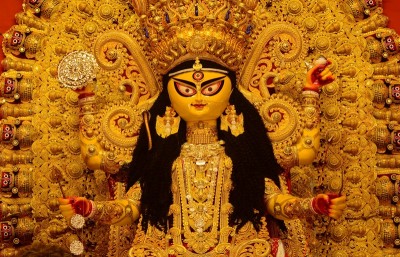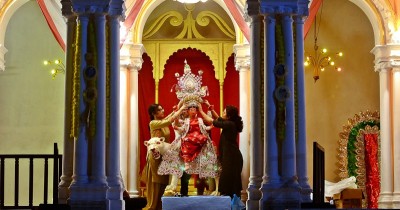
Earthly fabric
Can you look fashionable in khadi and confidently walk down the high street? Going by the summer collections of fashion houses, designers are waking up to the possibilities of the humble khadi. Indeed, when rain plays truant and the scorching sun beats down relentlessly, the Indian weaves come to the fashionista’s rescue to tackle the heat..jpg)
“Khadi as a fabric is most conducive to the hot season as it lets the body breathe. Basically, it’s a very versatile material. It keeps you warm in winter and cool in summer. It’s the safest bet for countries falling within the extreme tropical zone. And India is one,” opines Kolkata-based designer Jyoti Sachdev Iyer. Her silhouettes range from crop tops, capes, jackets, pencil skirts to cigarette pants and dresses in an eclectic colour palette.
“Long known as a poor-man’s cloth, khadi has morphed into a symbol of class and comfort amongst the swish set. This simple yet charming fabric follows a long route of evolution indeed,” observes designer Jhelum Rele Dalvi of designer label Vismaya Couture in Pune. “The contemporary couturiers have totally altered the appeal and appearance of khadi and it successfully stands up to present-day experimental trends. So even if you don’t dazzle and sizzle this season in glitzy materials, you can still be a showstopper,” she believers.
The hand-woven fabric’s heat-resistant quality and its element of all-weather friendliness also find an echo in Prateek Raja, director at Kanishka’s distinguished flagship store in Kolkata: “The soil-texture determines the nature of crops to be sown and cultivated in the region. Hence, most home-spun weaves on this side of the map are prone to be produced in humid areas. That’s why all our manufacturing units are located in these specific zones, where we’ve been working with the close-knit clusters of local weaving communities for the past forty-five years or so.”
.jpg) Representing the second-generation in the reputed family undertaking, Raja adds that, “ Khadi is soft to the touch, yet not subdued in expression. It conveniently induces ventilation and penetration of light, which is desirable in the sweltering climatic belts. It doesn’t stick to the body even during sweaty weather, and comes with an added edge of aesthetic earthiness.”
Representing the second-generation in the reputed family undertaking, Raja adds that, “ Khadi is soft to the touch, yet not subdued in expression. It conveniently induces ventilation and penetration of light, which is desirable in the sweltering climatic belts. It doesn’t stick to the body even during sweaty weather, and comes with an added edge of aesthetic earthiness.”
Ideal for the summer wardrobe, different handloom fabrics like malmals, chanderis, silk, linen and jute have gradually made inroads into the glamour circles. “You may strike the right chord and unleash an impressive style statement by slipping into interesting combos of khadi with cotton, silk or wool,” suggests Ushma Savla, senior manager, Weavers’ Studio, Kolkata.
“We Albeit have a regular footfall of clients all the year round; yet during long span of searing summers, we always decipher a steep rise in the sales of Indian weaves ranging from plain to embroidered stuff in kantha stitches, chiffon, georgette and tussar silk variety, available at our store. I have a hunch that these specimens are here to stay permanently and will grow from strength to strength for good,” says Darshan Shah, director, Weavers’ Studio.
While talking about the suitability factor of Indian weaves, light and airy, meant essentially for domestic consumption, one must simultaneously make a note of its surprising popularity in the overseas market too. Overseas orders pour in from the US, European countries, Australia, Japan, Singapore and Dubai.
.jpg)
The modern-day ‘wheel-spun, charkha-inspired’ costumes are now available in more vibrant shades than in its previously dull, muted avatar. “For instance, khadi is being woven in brighter hues with eye-stealing needlework to augment the fabric’s appeal. Hence, adopt the right manner to don it in the evenings with proper pizazz. “Chromes like oranges, rusts, blues and indigos accentuate the soothing brightness of this indigenous fabric to a great degree,” explains Iyer.
Prescribing a list of accessories that go with and enhance khadi-wear, Dalvi suggests: “One may wear a traditional headgear, bangles, waist-band and a payal with ghagra-choli for an Indian look, whereas for western wear, minimalism is the best bargain.”
Khadi also scores as a national fabric with its rich heritage, durability and a timelessness.
.jpg) Sadly, weavers are often marginalised and do not get their due. Acclaimed designer Nandan Das works with weavers of Phulia in Nadia district in West Bengal. “We want to support the local cottage industry which produces fine products.” He emphasises that “Fashion is not just for the affluent class but masses as well.” Hand-woven home products are also eco-friendly and recyclable , he reminds.
Sadly, weavers are often marginalised and do not get their due. Acclaimed designer Nandan Das works with weavers of Phulia in Nadia district in West Bengal. “We want to support the local cottage industry which produces fine products.” He emphasises that “Fashion is not just for the affluent class but masses as well.” Hand-woven home products are also eco-friendly and recyclable , he reminds.
“This resurgence of desi over phoren will undoubtedly benefit India’s economy in tandem with the fashion industry. It will help revitalise the use of those long forgotten natural fabrics and techniques which have died down in the spate of artificial, synthetic fibres and power-looms over the years,” says Shah.
Support Our Journalism
We cannot do without you.. your contribution supports unbiased journalism
IBNS is not driven by any ism- not wokeism, not racism, not skewed secularism, not hyper right-wing or left liberal ideals, nor by any hardline religious beliefs or hyper nationalism. We want to serve you good old objective news, as they are. We do not judge or preach. We let people decide for themselves. We only try to present factual and well-sourced news.







